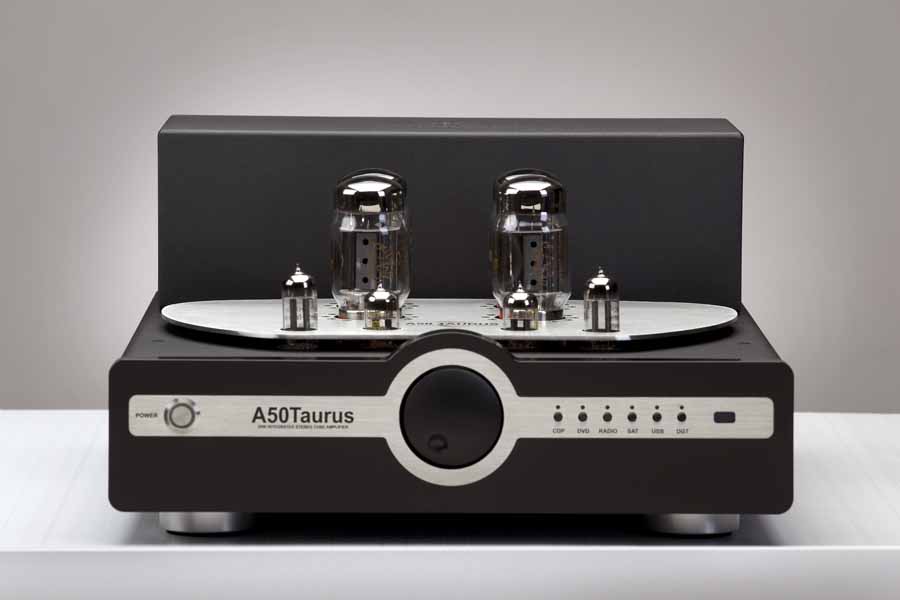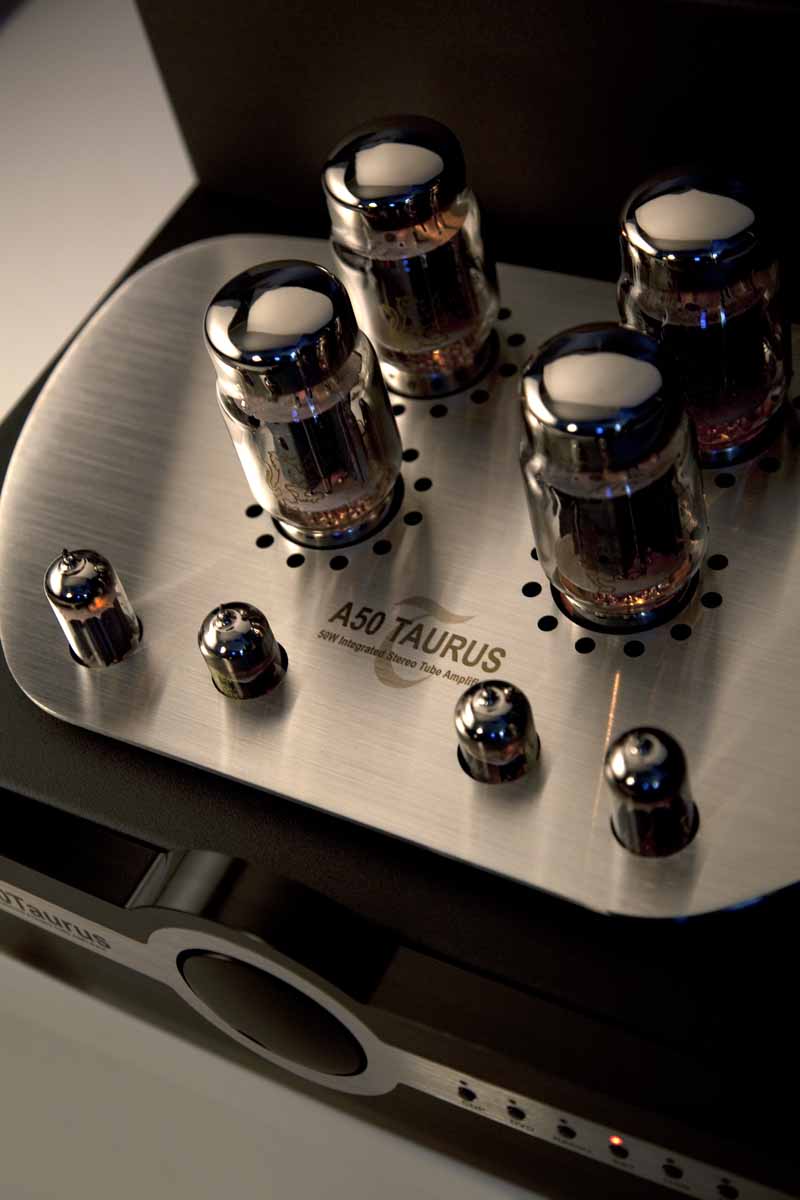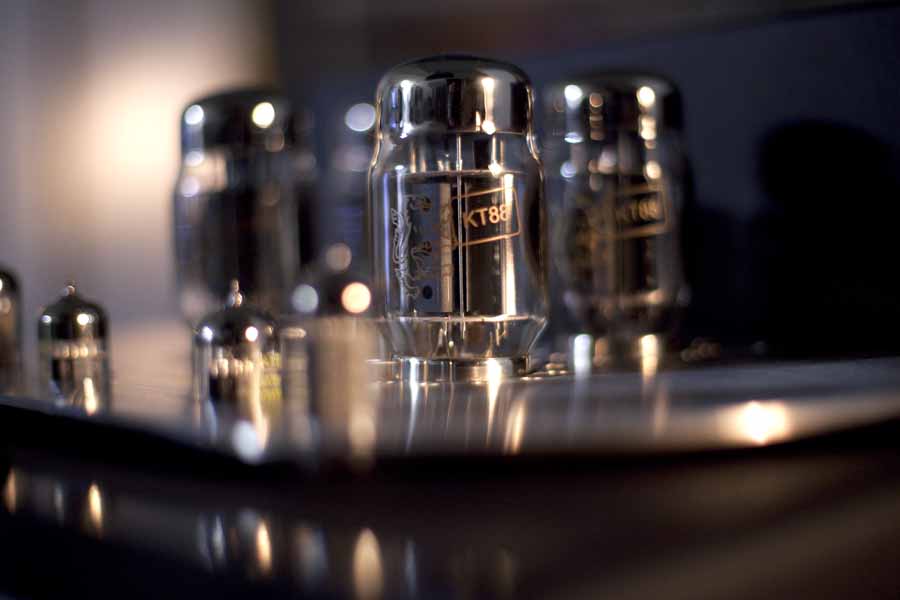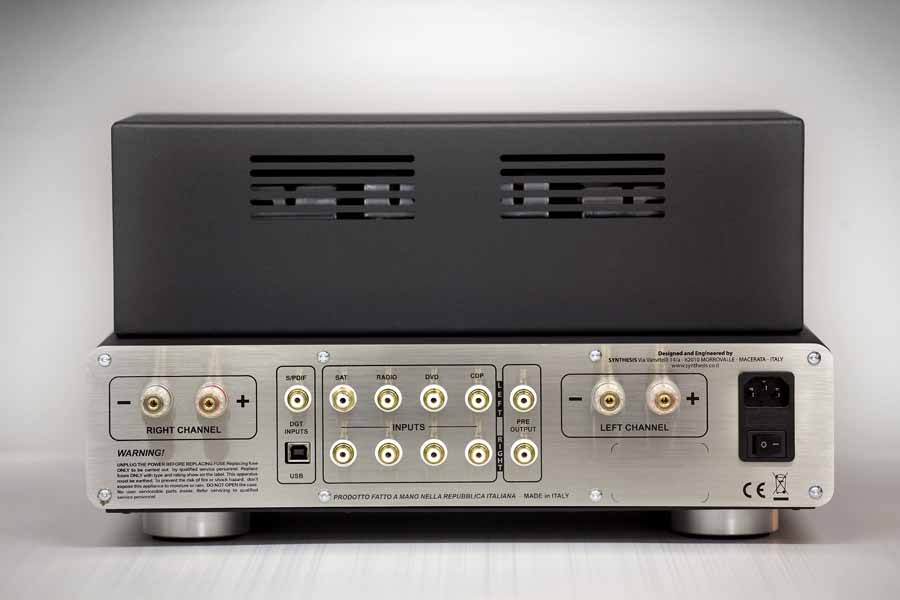SYNTHESIS A50 TAURUS AMPLIFIER REVIEW
The Synthesis A50 Integrated Amplifier with DAC costs £6199 in the UK and is now distributed by Henley Audio. It’s a behemoth of an integrated amp with plenty of inputs, a remote and an onboard DAC. Stuart Smith lifts it into place and takes a listen.

Front view of the A50 Taurus with the valves safely caged.
Synthesis is an Italian brand founded in 1992 by Luigi Lorenzon with al their amps being handmade in the city of Morrovalle. The company’s history goes back further than that, however, with Luigi’s father having founded a company called FASEL in 1961. FASEL made output transformers, power transformers, chokes, and inductors for instruments. With this kind of background in the family, it would seem somewhat a logical step for Luigi to have gone into the production of valve amplification for the home market. Janine Elliot took a listen to the company’s Roma 98 DC monoblocs last Autumn and liked them a lot – you can read the full review of the Roma 98 DC monoblocs here.
CONSTRUCTION, FEATURES & SPECS
First of all, and let’s not mince our words here, the Taurus is a beast of an amp in both size and weight, though it fitted on our Soundsteel amp stand with no problems at all. Dimensions are 42 x 45 x 26 cm and it weighs 35Kg. To support this heft there are four CNC machined aluminium feet that have a natural rubber insert whose depth and form have been calculated to minimise vibrations.

Another full frontal view with the tubes out for display
The amp is really well finished and looks very nice, though I’m some won’t like the front panel with its massive volume ‘knob’ and silver trim – personally, I think it looks rather splendid and certainly a standout from the plethora of black boxes that have been doing the rounds for years. The volume knob is actually pretty cool, sits flush to the casework, and has an indent for your finger – nice touch.
The case itself is very well finished and along the front has a series of six input LEDs. However, the red LED’s are also selection buttons which I really liked, though the CNC machined remote is an absolute delight to use and does everything you need it to – standby, volume, mute and six buttons for selecting the input channel.
Well Connected and Some
It’s around the back of the amp that things get interesting, and, as well as a pair of speaker binding posts (yes, all usual suspects accommodated) and the five RCA inputs for line-level sources, you also get inputs for USB and S/PDIF. The latter is a pretty cool thing to have on an amplifier like this I reckon. The DAC is a 24Bit 192KHz Wolfson affair and will decode PCM 32-192KHz/16-24bit vie the S/PDIF input or 16Bit/48KHz via the USB input. I really liked this feature as it meant I didn’t need to fanny about with a separate DAC and could simply add a line level source, or, as I did most of the time, a digital source like the Melco or Auralic units we have. Obviously, you can connect anything with and RCA S/PDIF output too and I did try this with our little Leema CD player with great results. Essentially, you could have a fully functioning streaming HiFi by adding the streamer/source of your choice, and a pair of speakers.
The amp has a cover to keep fingers and pets away from the valves but personally, I think it’s a crime to hide them away. Tubes used in the Taurus are 2 x KT88s (6550) in the power stage, a 12BH7 in the driver, and a 12AX7 (ECC83) in the input stage – this is per channel. One point here, one of the 12AX7s blew pretty much as soon as I turned on the amp. I contacted Ludovica at Synthesis and the next day but one I had a replacement – I like this kind of service! All the tubes utilise DC stabilised heater circuits to reduce hum, and through all the speakers I tried the amp with, I found it to be dead quiet. The ceramic, gold plated ceramic valve sockets were nice and tight when putting in the new valves, and this inspired confidence.
The output from the amp is a very healthy 50 Watts a channel in an ultra-linear, push-pull configuration and so all but the most power-hungry speakers will be absolutely fine. The Taurus, like the A100 Titan that outputs 100W a channel using 4 KT66 power tubes, features newly designed output transformers that use Hi-Grade Iron-Silicon, which Synthesis says improves “frequency reproduction and width”. Both power supply and the output transformers are held in a rigid H structure which the company says keeps them safe from unwanted vibrations that may otherwise find their way to the tubes and affect the sonic performance of the amplifier.

The A50’s valves on show
On start-up, there’s a button on the right of the front panel for this or you can click the remote, the amp goes through a warm-up cycle that is over when the red buttons on the front stop flashing.
THE SOUND
I listened to the A50 Tuarus using predominantly a Melco Library via USB and a Leema CD player via both S/PDIF outputs and line output. Loudspeakers were in the main the Audiovector R3 Arreté but also the old Celestion SL6S which are famously a difficult loudspeaker to make sing.
Respect My Authority
From the off, it was clear that the A50 a certain authority and I was particularly drawn to the way that it handled bass frequencies on the new Steven Wilson album (great record by the way). It certainly seemed that the amp was in control here without adding any bloom or overhang of its own. Actually, it’s pretty difficult to describe the feeling I’m getting when listening to this combo with regards to the bass – it’s sort of like having a car that you know can really let go when you hammer it, but still feels perfectly comfortable and even-tempered at lower volumes. A feeling that the amp can give a lot more power, I suppose. Power is of course nothing without control, and there’s never anything but the feeling of the A50 being in charge of the bass frequencies. Even at these relatively low volumes, the bass frequencies have great body and texture. Actually, it seems like the amp is playing a lot louder than it is, and by this I’m suggesting that there doesn’t seem to be anything missing from the recording as a whole – I’m getting the whole picture. Actually, and I’ve found this throughout my time with the A50 Taurus, the whole listening experience has been nothing but a joy.

A front view of the A50 Taurus showing the valve glow – a shame to leave such beauty caged up.
From a soundstage perspective, the amp allows the speakers to do their job properly and I find myself enjoying the soundscape rather than trying to over-analyse it. This is a good thing in that the amp settles you into a comfortable place immediately (well, after a bit of a warm-up period) with regards to the way it delivers music. And I suppose that’s the thing here – the A50 allows the music to flow and without it feeling constrained in any way. Does that sound a bit like the A50 is a bit “pipe and slippers” and soft focus? Well it isn’t, and the amp is as insightful as it is comfortable to listen to. There’s just an even-handedness to the presentation that relaxes you into the music you are listening to. Yes, I can hear little details in the background and, should I feel the need to, I can focus in on these and dissect them, but the truth is I don’t feel the need to (though that would make for a boring review) and just want to listen to my tunes. One of the things that helps here with the soundstage is the apparent absolute silence of the amplifier – the noise floor is very low and so you hear more accurately the music. Stereo imaging is very stable and perfectly presented using the R3s.
An amp really shouldn’t add anything of its own make-up and the A50 sort of doesn’t, though I want to use the word warm…but that’s not really the right word. Warm would suggest a woolly and rolled-off presentation that is perhaps smeared at the edges, but it’s not. I suppose it’s perhaps better to describe what the A50 isn’t – it isn’t harsh, hard, or etched in its presentation. It is even-handed and has a delicateness of touch that just draws you into the tunes you are listening to. Vocals are silky smooth and then Fish’s Garden of Remembrance comes on via Roon as I’m scribbling down my notes. It’s not a record I know at all, but the vocal is sublimely projected into the room – well forward, and full of richness and emotionally connecting. I bat on plenty about that emotional connection thing and so won’t bore you with how important I find it again!
Electronic music is equally well presented and on Koenig Cylinders’ 99.9 you really do get he full spectrum of sounds presented and without the amp adding very much at all. It’s all well and good an amp pandering to folk who listen to music to make their HiFi’s sound great, that’s pretty easy, but what a good amp should do in my opinion is play everything well and without adding too much of itself to the final sound coming out the speaker, and the A50 does this. On the 99.9 track you can delineate all the individual sounds – the hats are sharp as they should be and the kick has power and texture. This music demands to be played loud and so the volume goes up and here is where the amp really does deliver. It’s not that the amp is doing anything different to what it was doing when playing at moderate volumes- there’s just more impact and volume. There is still the same feeling that the amp is barely breaking a sweat and that same feeling of control. There’s also that same detail to individual sounds if you do want to pull the track apart. This track gets a bit mental towards the last quarter of it but the A50 doesn’t get flustered at all! From a volume perspective, I’m able to listen LOUD without feeling overwhelmed or getting that cringing feeling (you’ll know what I’m on about) when something just feels pushed too far and begins to break up.
A key feature of the character of the A50 is just how dynamic it is and this was evident whatever I music I played – the Sabres Of Paradise Mix of Chemical Brothers’ Leave Home’s kick is tremendously portrayed. A sound starts and it’s there in front of you and gone thereafter if that’s what the mix does. However, effects like decay and reverbs are properly represented and can, again if the mix demands, hang in the mix. Intimate recordings Basement Jaxx’ Romeo (Acoustic Version) gives a great sense of the recording.
One of the major features of this amp is the onboard DAC and it’s certainly no shirker. Is it as good as our standalone LAB12 dac1 in our second system or the Leema Pulse DAC in our main system? Well, no it’s not. However, unless you have better DACs there to switch in and out as we do then you really aren’t going to think the DAC on the A50 is anything but a fabulous addition to an already very good amplifier. I have no complaints about it all.
One small niggle is that the amp picks up that annoying noise you get from time to time when a mobile phone is in very close proximity to it – you know the noise I’m on about. It only happened maybe three or four times whilst I was listening to the amp in our system, but it is worth pointing out never-the-less.
So, the A50 is comfortable with the relatively easy load and temperament of the Audiovector R3 Arreté but the point of reviewing something is to see if you can push it beyond what it is comfortable with and give it a bit of a challenge – within the constraints of what it can feasibly cope with. And so without further ado, we wire up the Celestion Sl6S loudspeakers. These are a great loudspeaker from the 80s but are notoriously a pain in the arse to get singing, requiring, as they do, a fair bit of oomph up ‘em. This should be interesting!

From the side showing the KT88 power valves
I think it’s fair enough to use similar kinds of tracks as I used through the Audiovectors, but I’m not going to go into detail about each track and will talk in broader terms. First of all it’s clear that these speakers do prefer a bit more of a click on the volume button on the remote than the R3s but they do seem to get on very well with the A50. Overall I think they prefer the Class A power of our Krell but the A50 really did energise them very well and to a good volume.
CONCLUSION
First of all, let me say that the A50 is a terrific match for the Audivector R3s – the amp really did bring them on song and if you are an owner of these particular speakers or the R1s we recently reviewed (yes I did sneak a quick listen with the A5 powering them), then give this amp at least some consideration.
With the above said, the A50 also coped very well with the more difficult challenges I threw at it – the SL6S, for instance.
In more general terms the A50 represents all that is good in high-quality, high-powered valve amplification. You have that required grunt and headroom that decent power delivery gives you, but you also have an almost indefinable textural quality to the music that is presented, particularly in the mid-band.
The noise floor on the amp is incredibly low and there always seems to be a little more to give in terms of power. I pushed the amp hard and never felt it was running out of puff.
The A50 digs down low and deep but doesn’t overblow the bass, tops are an easy listen and not piercingly sharp (though neither are they rolled off) and mids, particularly vocals that are mixed forward, are really wonderfully projected into the room.
The A50 Taurus looks good, is well built, and has a great remote control plus there is the addition of the DAC that just adds to the value of the package.
Perhaps a headphone amplifier would have been a nice inclusion, but that’s just being picky!
AT A GLANCE
Build Quality:
Well finished and good looking, though certainly not run of the mill. Very heavy and with a great remote that is simple but a delight to use. Overall it feels and looks more expensive than it actually is
Sound Quality:
A dynamic and yet subtle amplifier that has enough grunt to power difficult loudspeakers. Very low noise floor from which music just flows effortlessly. A real joy to have had in the system, whatever the music.
Value For Money:
It’s a beast of an amplifier that sounds great and has a perfectly good DAC onboard. Very good value.
We Loved:
Build and remote
Dynamic, detailed, and powerful sound
Subtle and engaging when needed
Feels like a high-end product at a mid-fi price-point
Decent enough DAC
Flexible with regards to speakers you can partner it with
We Didn’t Love So Much:
Could do with a headphone amp for late-night solitary listening
Takes a little while to get on song after powering up
No onboard phonostage
Not everyone is going to like the styling
Picks up phone noise if one is very close
Price: UK £6199, EU € 6750, US $6900
Elevator Pitch Review:
A keenly priced amp with a perfectly good onboard DAC and with power enough to satisfy all but the most power hungry of loudspeakers. Just add speakers and a source

Stuart Smith
Supplied By Synthesis Art in Music
Review Equipment: Melco Library running Roon, Audiovector R3 Arreté and Celestion SL6s loudspeakers, Atlas speaker cables, Chord Interconnects and Tellurium Q USB cable. Solidsteel speaker and amplifier stands.



















































































































































































































You must be logged in to leave a reply.